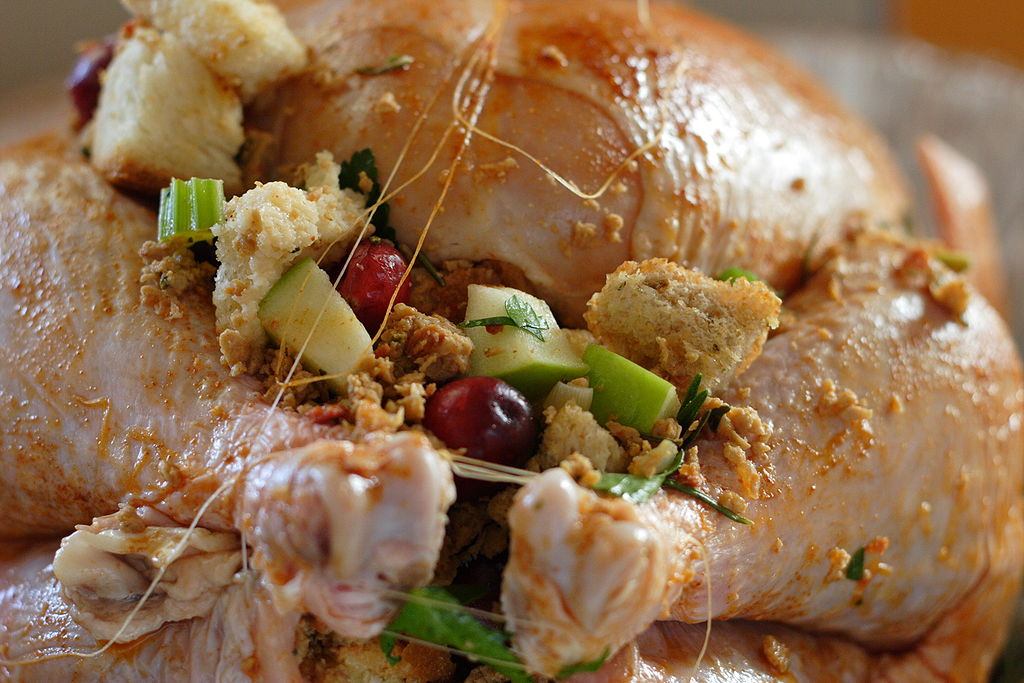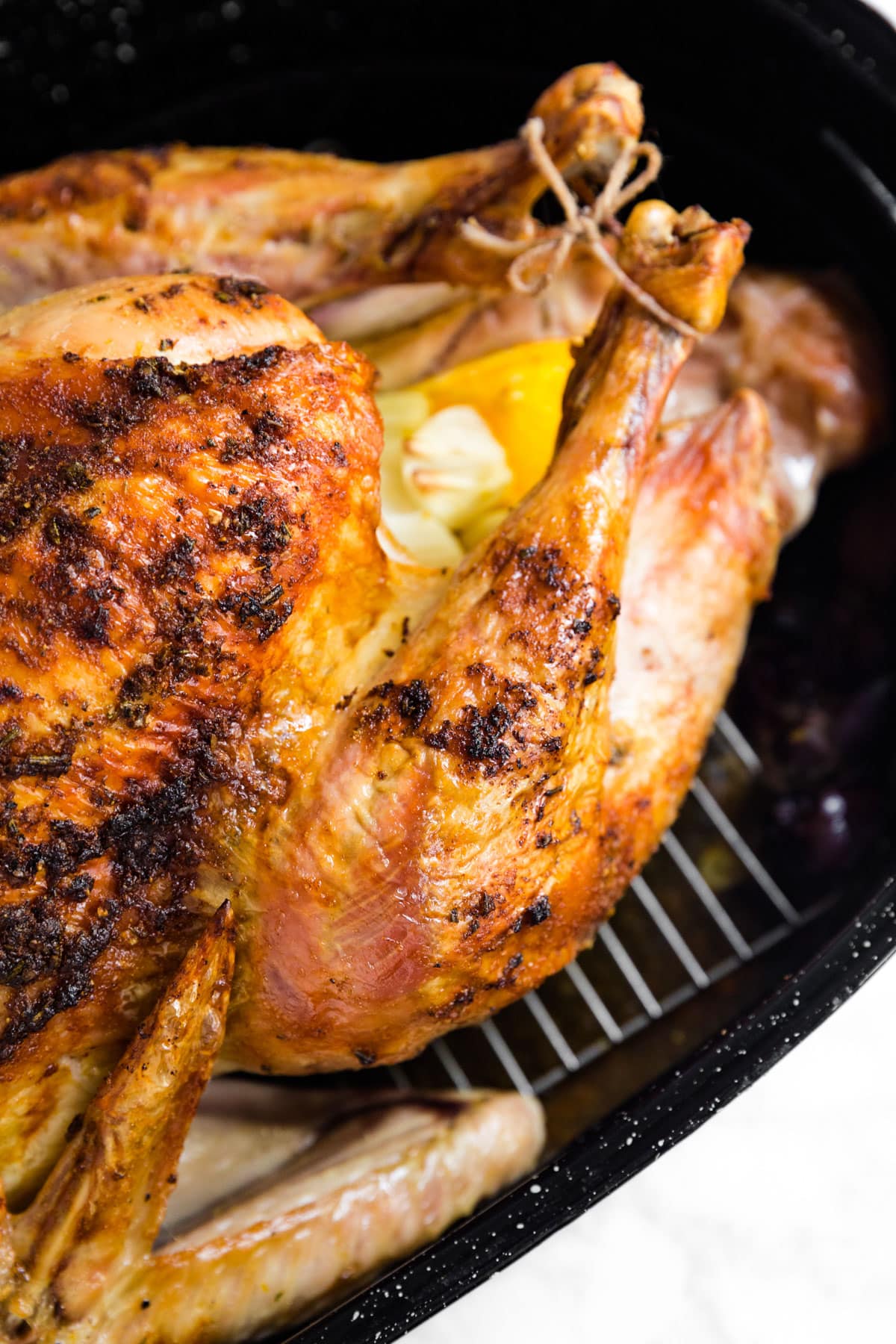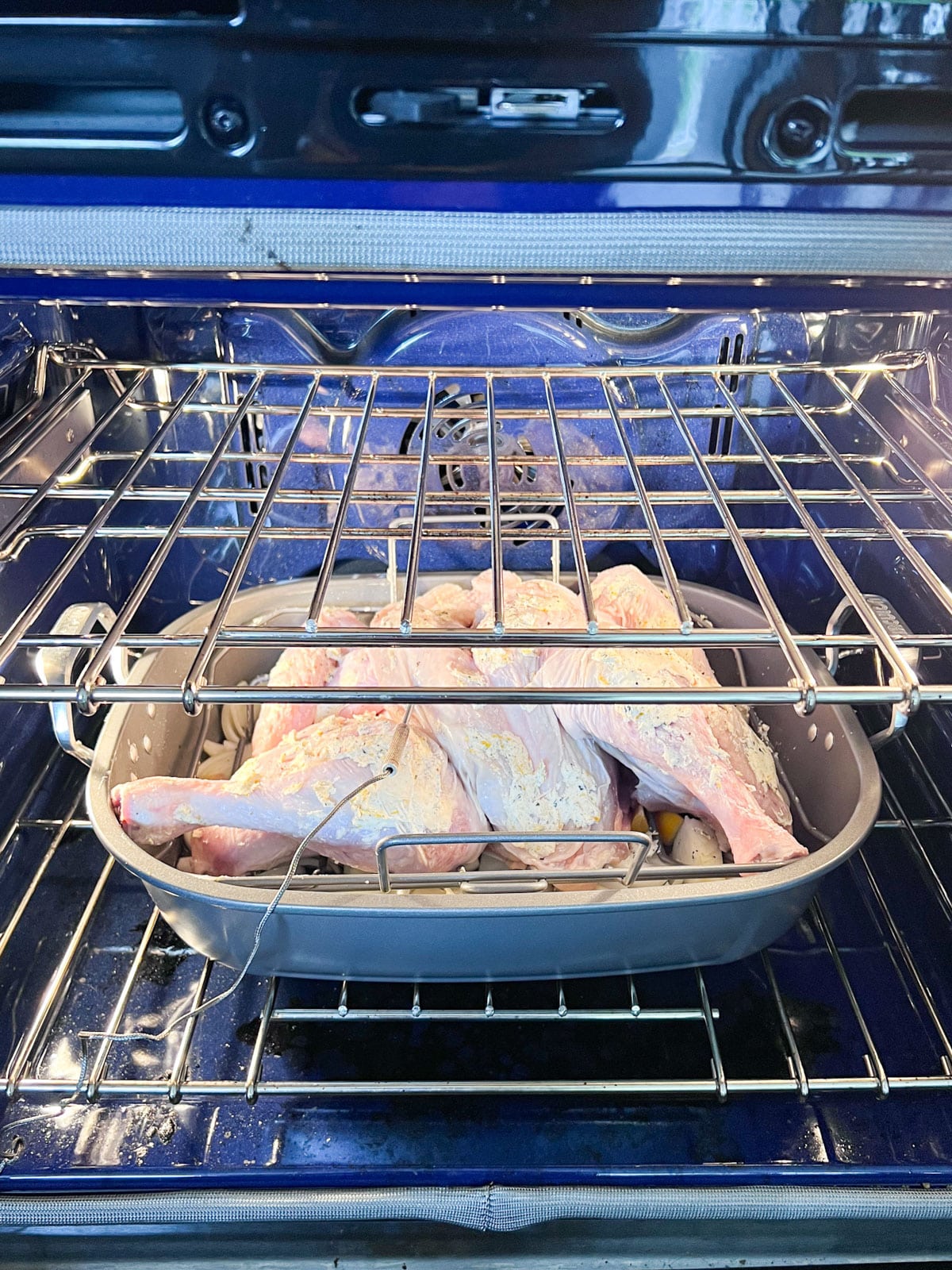Whole turkey with oranges and rosemary is seriously delicious. This is a super easy turkey recipe where the flavors blend magically, giving you a delicious, impressive turkey without any hassle.
As Thanksgiving approaches, home cooks everywhere are gearing up to prepare the star of the Thanksgiving meal – the turkey! While there are many ways to prepare turkey, one unique and delicious method is to stuff the turkey cavity with oranges Stuffing a turkey with oranges results in a bird that is bursting with bright, citrusy flavor and enhanced moisture.
In this article, we will explore the benefits of stuffing your turkey with oranges, provide tips on how to do it properly, and share a complete recipe for orange stuffed turkey perfection!
Why Stuff Your Turkey with Oranges?
Oranges add tremendous flavor and moisture to a roasted turkey. As the turkey cooks, the orange juice permeates the meat, keeping it tender and infusing it with tangy sweetness. The acidity in the citrus also helps break down the turkey proteins, making the meat more tender.
In addition to moisture and flavor oranges add some great nutrition. Oranges are packed with vitamin C, an important antioxidant. They also provide potassium, fiber and other key nutrients.
Stuffing oranges inside the cavity helps spread that flavor throughout the turkey, rather than just on the surface. The bright color also adds some lovely visual appeal to your holiday table.
Choosing the Right Oranges
When selecting oranges for turkey stuffing, look for juicy, thin-skinned varieties like navel oranges. The thinner the peel, the more flavor that will impart into the turkey meat. If you can only find thicker-skinned oranges, no problem! Just be sure to peel them first before stuffing.
For the most flavor, choose oranges that are ripe and sweet. Give them a taste test – they should be bursting with sweet citrus flavor. Too tart, and they may overwhelm the other flavors.
Aim for large oranges that will fit nicely into the cavity and add plenty of moisture. About 4-5 oranges for a 15 lb turkey should do the trick.
Preparing the Oranges
Getting the oranges ready is quick and easy:
-
Wash the oranges thoroughly, even if you plan to peel them. This removes any dirt and residues.
-
If using thin-skinned oranges like navels, you can stuff them as-is with peels on. For thicker skinned varieties, peel the oranges first.
-
Slice the oranges into rounds about 1/2 inch thick. This will allow the juices to release into the turkey as it cooks.
-
Inspect the orange slices and remove any obvious seeds. Don’t worry about getting every last seed – just remove the large, obvious ones.
-
Place the prepared orange slices into a bowl until ready to stuff the turkey.
Stuffing the Turkey with Oranges
Once your oranges are prepped, it’s time for the fun part – stuffing the bird! Here are some tips:
-
Start with a 15-16 lb turkey if possible. The larger cavity size will fit more oranges.
-
Remove any giblets or neck from the turkey cavity. Rinse thoroughly.
-
Pat the turkey dry, inside and out.
-
Place a few herb sprigs like rosemary, thyme or sage in the bottom of the cavity. This adds flavor as the juices drip down.
-
Pack the orange slices into the cavity, alternating with more herb sprigs.
-
Don’t pack too tightly. The stuffing needs a bit of room to expand as the turkey cooks.
-
Put any extra orange slices around the turkey in the roasting pan. They’ll add even more flavor!
-
Tuck the legs and wings in toward the body.
-
Roast the turkey as you normally would, basting with pan juices as it cooks.
Cooking Times
Stuffed orange turkey takes a bit longer to roast since you’ve added mass to the cavity. Here are some general roasting guidelines:
-
12-15 lb turkey: Roast at 350°F for 3 to 3 1/2 hours
-
16-18 lb turkey: Roast at 350°F for 3 1/2 to 4 hours
-
20+ lb turkey: Roast at 350°F for 4 to 4 1/2 hours
Always use a meat thermometer to confirm doneness rather than relying solely on time. Juices should run clear and the thickest part of the thigh should reach 165°F.
Let the turkey rest at least 15 minutes before carving to allow the juices to settle.
Serving Suggestions
Once roasted, your orange stuffed turkey will be irresistible! The turkey will take on a slight citrus note while remaining perfectly moist.
Offer the orange slices from the cavity as a garnish or side. Squeeze them over the sliced turkey to further enhance the flavor.
Pair your turkey with classic Thanksgiving side dishes like mashed potatoes, roasted vegetables, stuffing and cranberry sauce. The orange notes will complement these perfectly.
Use any pan juices to make a quick orange gravy or orange cranberry sauce. Simply delicious!
Orange turkey also makes fantastic leftovers. Wrap slices in flour tortillas with lettuce, avocado and a tangy yogurt sauce for easy turkey tacos.
Frequently Asked Questions
Should I truss the turkey?
Trussing is optional but recommended. It pulls the legs inward and compacts the body, allowing it to cook more evenly. Just be careful not to pack the cavity too tight.
Can I prepare the oranges ahead of time?
Absolutely! Slice the oranges up to 8 hours before roasting the turkey. Store them in the refrigerator until ready to use.
Do I still need to baste the turkey?
Yes, basting helps ensure a golden, crispy skin. Baste every 30 minutes with the pan juices.
What if my turkey doesn’t have a pop-up timer?
Don’t rely solely on the pop-up timer for doneness. Always check the internal temp in the thickest part of the thigh with a meat thermometer.
Can I use other citrus fruits besides oranges?
Oranges work best, but you could certainly experiment with other citrus like grapefruit, clementines or lemons for a variation.
Orange Rosemary Turkey
This recipe brings all the elements together into one show-stopping entree! Feel free to double it for a larger gathering.
Ingredients:
- 1 (12-15 lb) whole turkey
- 3 medium navel oranges, sliced 1⁄2 inch thick
- 1 lemon, sliced
- 1⁄4 cup loosely packed fresh rosemary leaves
- 2 tablespoons olive oil
- 1 tablespoon kosher salt
- 1 teaspoon black pepper
Instructions:
-
Rinse turkey inside and out; pat dry with paper towels.
-
Fill cavity with orange and lemon slices, alternating with rosemary sprigs. Truss turkey legs if desired.
-
Rub outside of turkey with olive oil. Sprinkle all over with salt and pepper.
-
Place turkey on a roasting rack in a shallow pan. Surround with any remaining fruit slices and rosemary sprigs.
-
Roast at 350°F for 3 to 4 hours until internal temperature in thickest part of thigh reaches 165°F.
-
Let rest 15 minutes before slicing.
-
Serve turkey topped with roasted citrus slices. Enjoy!
The oranges and rosemary will infuse the turkey with incredible citrus flavor and aroma. The fruit keeps the meat deliciously moist and tender. It makes for a spectacular and memorable Thanksgiving centerpiece.
Make This Thanksgiving One to Remember
Turkey with orange stuffing is a fun twist on the traditional Thanksgiving bird. With its beautiful color, mouthwatering aroma and succulent flavor, your guests will be impressed. The citrus accent adds so much flavor while keeping the meat perfectly moist.
Follow the tips above for choosing the best oranges and stuffing your turkey properly. Roast slowly, basting frequently, until the meat is cooked through. Rest before slicing and garnish with the roasted fruit.
From the eye-catching presentation to the amazing taste, orange stuffed turkey is sure to become your new favorite Thanksgiving tradition. Surprise and delight your guests this year with a turkey that’s juicy, vibrant and full of bright, sunshine citrus flavor!

Frequently Asked Questions and Turkey Troubleshooting
No problem, this will also work well with olive oil and add a another ¼ teaspoon of salt to the rub. Its a slightly different flavor but still delicious.
No biggie, it happens to us all from time-to-time! For the legs, leave the drums and thighs connected and either pop them back into the pan with the juices or braise them in the cooking juices in a large pan on the stovetop. For breast meat, Id encourage you to leave that on the carcass, tent it in foil to prevent the skin from burning and pop it back into the pan. Either way keep an eye on it so that you dont accidentally overcook it! One thing to note is that breast meat tends to cook a little faster than leg meat, so you can always start with carved breast meat while the leg meat comes to temp.
Ive got you! Submerge it (the whole turkey must stay fully submerged) in cold water, Throw a few ice cubes in so it stays below 40 degrees. Change that water every 30 minutes (seriously, set a timer!) planning on around 30 minutes per pound and then cook right away once thawed. Also, stir it once in a while while thawing.
Its ok, send your spouse or dad or someone equally as awesome to the store and have them grab a package of turkey thighs- my Roast Turkey Thighs for Two recipe can be ready in an hour!
Itll be ok! The dark meat is fattier and tends to be more tender so thatll probably be fine. As for the breast meat, cover it in pan drippings and turkey (or chicken broth) and pop it back into the oven for a few minutes. And then use plenty of gravy when serving.

How To Slow Roast Turkey
When roasting a whole turkey, youll want to start at a higher heat to render some of the fat out quickly before reducing the heat for the remainder for the cooking time. While it typically takes around 20 minutes of cooking per pound there can be a ton of variables that can change this, so my biggest turkey cooking rule is cook by temperature not by time for a perfectly cooked turkey.
Here’s how I cook my turkey:
- I start my bird at 450 degrees for the first 20 minutes and then reduce the heat to 350 degrees for the remainder of the cooking time.
- To get the right temperature, insert the thermometer into the thickest part of the thigh, near where the thigh meets the breast and push it into the thigh meat. Make sure you dont touch any bone (if you have a duel probe you can also place the other one into the other thigh). I also like to have a good instant read thermometer to double check but this is optional.. That said, dont rely on the pop up thermometers that come in the turkey.
- To baste or not to baste? There are certainly arguments on both sides. Ive done it both ways, but I havent really been pulled strongly in either direction. The turkey in my s was not basted and as you can see, it has some gloriously crispy skin. At the end of the day, I didnt want to let heat out of the oven and have to extend my cooking time, so I didnt baste. But you do you!
- If the turkey breast is getting too dark too quickly (check it periodically) you can tent just that part with foil to help keep it from burning.
- I recommend pulling the turkey out of the oven at 161 degrees. While technically poultry is safe to eat at 165 degrees, it will continue to cook while it rests and get up to 165 degrees during that time while staying tender and juicy.
- Make sure you rest your turkey for at least 30 minutes to redistribute the juices before carving.

